Galaxies
A galaxy is a family of stars, held together by their mutual gravitational
attraction, and with a distinct identity separating it from other galaxies.
Galaxies cover a huge range of size and mass as well as exhibiting a variety
of structures and properties. The smallest galaxies known are relatively
nearby dwarf galaxies containing only 100,000 stars, fewer than in a typical
globular cluster. At the other end of the scale, the most massive galaxy
known, the giant elliptical M87, contains 3,000 billion solar masses, about
15 times more than our own Galaxy.
Most galaxies can be categorized into a number of broad morphological types.
Spiral galaxies are disc-shaped, with a central bulge, from which spiral
arms appear to wind outwards. In barred spirals, a bar of stars extends out
from the bulge and the arms appear to be attached to the ends of the bar.
Spiral galaxies contain very luminous young stars and significant amounts of
interstellar material concentrated in the arms.
Most of the conspicuous galaxies in the sky are spirals, but the most
numerous type is the elliptical galaxy. Both the smallest and largest
galaxies are of this kind. They are thought to consist entirely of old stars
with relatively little interstellar material.
The third main group is that of irregular galaxies, which are neither spiral
nor elliptical. These account for up to a quarter of all known galaxies. At
visible wavelengths, irregular galaxies show no particular circular symmetry
and look chaotic.

Description:
NGC 660 Galaxy.
Date: 2013.
Credit: Alex Tudorica (AIfA and ING collaborator) and Ovidiu Vaduvescu (ING).
Technical information:
Telescope: 4.2-m William Herschel Telescope.
Instrument: Prime Focus Imaging Camera.
Detector: Red+4.
Filters and exposure times: This composite image was obtained in Johnson-Bessel BVR filters taken during the first light of PFIP's Red+4 detector on the 27th of September 2013. The combined total exposure time was 40 minutes.
Available formats: ING image release, 4 December 2013.

Description:
The spiral galaxy NGC 7217 in Pegasus.
Date: 2005.
Credit: Mischa Schirmer (ING) and Gilles Bergond (IAA, Granada).
Technical information:
Telescope: 4.2-m William Herschel Telescope.
Instrument: Prime Focus Imaging Camera.
Detector: EEV.
Filters and exposure times: B, V and R.
Available formats: [ JPEG (1489 K) | TIFF (16,991 K) | PDF (with text) ]
1 2
2 3
3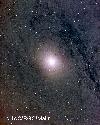 4
4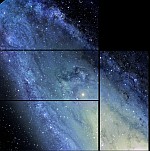
Description: Images 1,2,3: The nearest comparable spiral galaxy to the Milky Way is
M31 (NGC 224), the great galaxy in Andromeda. It is visible to the
unaided eye and has been known as a curious hazy patch since
ancient times. Only in the last 75 years has its nature as a distant
city of stars like the Milky Way become apparent. Image 3 shows
the central part of M31, the huge mass
of stars that are in orbit around its nucleus. Silhouetted against
this starry background are tangled sheets and curtains of dust,
very reminiscent of dust clouds we see in our own galaxy. At the heart of
M31 is a tiny, bright nucleus, seen to be slightly elongated. Hubble Space
Telescope pictures show the nucleus to be a double structure, possible the
remains of the nucleus of another galaxy which has now been almost
completely absorbed in M31. Around the binary nucleus swirls a huge cloud of
mostly old, faint stars. These stars are unresolved on the plates that were
used to make picture 3 and have been removed by a photographic process known
as 'unsharp masking'. PDF (with text).
Date: Images 1,2,3: 1992. Image 4: 2007.
Credit: Images 1,2,3: Malin-IAC-RGO (copyright). Image 4: F. Vilardell, I. Ribas and C. Jordi, N. Szymanek.
Technical information: Images 1,2,3: These 3 pictures are 3-colour photographic
compositions from the Isaac Newton Telescope. Image 4: Image obtained using the Wide Field Camera on the Isaac Newton Telescope and filters B and V.
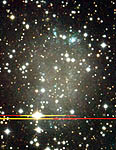
Title: Cepheus Galaxy.
Description: Dwarf Galaxy of the Local Group.
Credit: Mike Irwin (IoA).
Date: 2001.
Technical information:
Telescope: Isaac Newton Telescope.
Instrument: Wide Field Camera.
Detector: EEV 4280.
Filters and exposure times: 1200 second exposures in Sloan Gunn g, r and i.
Available formats: [ JPEG (335 K) | TIFF (8,796 K) ]
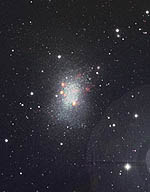
Title: Sextans B Irregular Galaxy.
Description: This image comes from the Local Group Census Wide Field programme on the INT.
Credit: Romano Corradi (ING).
Date: 2002.
Technical information:
Telescope: Isaac Newton Telescope.
Instrument: Wide Field Camera.
Detector: EEV 4280.
Filters and exposure times: H-alpha, [OIII] and Stromgren Y.
Available formats: [ JPEG (204 K) | TIFF (7,550 K) ]
1: 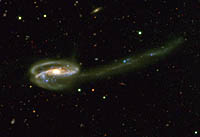 2:
2: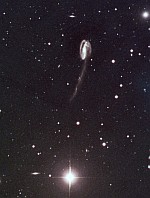
Title: Tadpole Galaxy (ARP 188 or UGC 10214).
Description: This galaxy has a stream of material flowing out of it, as it is interacting with another galaxy. In this case, the stream of material is apparently flowing towards nothing.
Credit:
1: Neil Trentham and Simon Hodgkin (IoA).
2: Alex Tudorica.
Date:
1: 2001.
2: 2010.
Technical information:
1: Telescope: Isaac Newton Telescope.
Instrument: Wide Field Camera.
Detector: EEV 4280.
Filters and exposure times: Filters Sloan Gunn u, g and i.
2: Telescope: Isaac Newton Telescope.
Instrument: Wide Field Camera.
Detector: EEV 4280.
Filters and exposure times:50s in R (Harris), i (Sloan) and g (Sloan) filters.
Available formats:
1: [ JPEG (110 K) | TIFF (4,704 K) ]
2: [ JPEG | TIFF ]

Title: NGC 520.
Description:
Credit: ING Archive and Nik Szymanek.
Date: 1995.
Technical information.
Telescope: Jacobus Kapteyn Telescope.
Instrument: JAG CCD Camera.
Detector: Tek.
Filters and exposure times: Filters B, V and R.
Available formats: [ JPEG (99 K) | TIFF (12,243 K) ]

Title: NGC 4826 or M64.
Description:
Credit: ING Archive and Nik Szymanek.
Date: 1995.
Technical information.
Telescope: Jacobus Kapteyn Telescope.
Instrument: JAG CCD Camera.
Detector: Tek.
Filters and exposure times: Filters B, V and R.
Available formats: [ JPEG (53 K) | TIFF (11,886 K) | PDF (with text) ]

Title: NGC 4486 or M87.
Description:
Credit: ING Archive and Nik Szymanek.
Date: 1995.
Technical information.
Telescope: Jacobus Kapteyn Telescope.
Instrument: JAG CCD Camera.
Detector: Tek.
Filters and exposure times: Filters B, V and R.
Available formats: [ JPEG (67 K) | TIFF (11,698 K) ]

Title: NGC 4038 or the Antennae.
Description:
Credit: ING Archive and Nik Szymanek.
Date: 1995.
Technical information.
Telescope: Jacobus Kapteyn Telescope.
Instrument: JAG CCD Camera.
Detector: Tek.
Filters and exposure times: Filters B, V and R.
Available formats: [ JPEG (83 K) | TIFF (11,268 K) ]

Title: NGC 3627 or M66.
Description:
Credit: ING Archive and Nik Szymanek.
Date: 1995.
Technical information. Jacobus Kapteyn Telescope, JAG CCD Camera, Tek detector. Filters B, V and R.
Available formats: [ JPEG (63 K) | TIFF (12,005 K) ]
1 2
2
Title: NGC 3034 or M82.
Description: M82 is of irregular morphology and a starburst prototype galaxy.
Credit:
1: ING Archive and Nik Szymanek.
2: Pablo Rodríguez-Gil (ING/IAC) y Pablo Bonet (IAC).
3: Elizabeth A. Cooke (Nottingham), Nina Hatch (Nottingham), Teo Mocnik (ING).
Date:
1: 1995.
2: 2010.
3: 2014.
Technical information.
1: Jacobus Kapteyn Telescope, JAG CCD Camera, Tek detector. Filters B, V and R.
2: William Herschel Telescope, HalfaRGB image obtained using ACAM.
3: William Herschel Telescope, Sloan i, Sloan r and Sloan g, obtained using ACAM. Supernova SN2014J is marked, see http://www.ing.iac.es/PR/press/m82_sn2014j.html for more information.
Available formats:
1: [ JPEG (63 K) | TIFF (12,005 K) ]
2: [ JPEG | PDF (with text)]

Title: NGC2841.
Description:
Credit: ING Archive and Nik Szymanek.
Date: 1995.
Technical information.
Telescope: Jacobus Kapteyn Telescope.
Instrument: JAG CCD Camera.
Detector: Tek.
Filters and exposure times: Filters B, V and R.
Available formats: [ JPEG (50 K) | TIFF (12,159 K) ]

Title: NGC2685 Galaxy or the Helix Galaxy.
Description:
Credit: ING Archive and Nik Szymanek.
Date: 1995.
Technical information.
Telescope: Jacobus Kapteyn Telescope.
Instrument: JAG CCD Camera.
Detector: Tek.
Filters and exposure times: Filters B, V and R.
Available formats: [ JPEG (57 K) | TIFF (11,605 K) ]

Title: NGC2403 Galaxy.
Description:
Credit: ING Archive and Nik Szymanek.
Date: 1995.
Technical information.
Telescope: Jacobus Kapteyn Telescope.
Instrument: JAG CCD Camera.
Detector: Tek.
Filters and exposure times: Filters B, V and R.
Available formats: [ JPEG (91 K) | TIFF (12,088 K) ]

Title: NGC2336 Galaxy.
Description:
Credit: ING Archive and Nik Szymanek.
Date: 1995.
Technical information.
Telescope: Jacobus Kapteyn Telescope.
Instrument: JAG CCD Camera.
Detector: Tek.
Filters and exposure times: Filters B, V and R.
Available formats: [ JPEG (67 K) | TIFF (11,840 K) ]

Title: NGC1961 Galaxy.
Description:
Credit: ING Archive and Nik Szymanek.
Date: 1995.
Technical information.
Telescope: Jacobus Kapteyn Telescope.
Instrument: JAG CCD Camera.
Detector: Tek.
Filters and exposure times: Filters B, V and R.
Available formats: [ JPEG (113 K) | TIFF (12,089 K) ]

Title: M77 Galaxy.
Description:
Credit: ING Archive and Nik Szymanek.
Date: 1995.
Technical information.
Telescope: Jacobus Kapteyn Telescope.
Instrument: JAG CCD Camera.
Detector: Tek.
Filters and exposure times: Filters B, V and R.
Available formats: [ JPEG (102 K) | TIFF (11,898 K) ]
1 2
2 3
3
Title: M74 Galaxy or NGC 628.
Description:
This conspicuous spiral is a prototype of a grand-design Sc galaxy. Its distance may be about 30 to 40 million light years as it recedes with 793 km/sec. Then its spiral arms are about 1000 light years broad. They are traced with clusters of blue young stars and pinkish colored diffuse gaseous nebulae (H II regions), and reach out to cover a region of more than 10 minutes of arc in diameter, corresponding to roughly 95,000 light years, or about the same size as our Milky Way galaxy.
Credit:
Image 1: Paul Vreeswijk and Nik Szymanek.
Image 2: ING Archive and Nik Szymanek.
Image 3: Simon Dye (Cardiff University).
Date:
Image 1: 2001.
Image 2: 1995.
Image 3: August 2004.
Technical information:
Telescope+Instrument+Detector:
Image 1: Isaac Newton Telescope+Wide Field Camera+EEV CCD.
Image 2: Jacobus Kapteyn Telescope+JAG CCD Camera+Tek CCD.
Image 3: Isaac Newton Telescope+Wide Field Camera+EEV CCD.
Filters and exposure times:
Image 1: Filters V, R and I.
Image 2: B, V and R.
Image 3: 2 × 100s exposures in B, 2 × 80s exposures in V and 2 × 60s exposures in R. This image was created with the help of the ESA/ESO/NASA Photoshop FITS Liberator.
Available formats:
Image 1: JPEG (55 K) | TIFF (15,921 K)
Image 2: JPEG (117 K) | TIFF (11,935 K)
Image 3: JPEG (62 K) | JPEG (105 K) | TIFF (3368 K) | PDF (with text)
1 2
2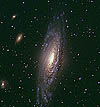
Title: NGC 7331 Galaxy.
Description:
Credits:
Image 1: Daniel Bramich (ING) and Nik Szymanek.
Image 2: Edward Conway, Nathan Horleston and Steve Maddox (University
of Nottingham) and Nik Szymanek (University of Hertfordshire).
Dates:
Image 1: 2001.
Image 2: 6 August 2002.
Technical information.
Image 1:
Telescope: Jacobus Kapteyn Telescope.
Instrument: JAG CCD Camera.
Detector: SITe2.
Filters and exposure times: B, V, R (10*100s on each filter).
Image 2:
Telescope: Isaac Newton Telescope.
Instrument: Wide Field Camera.
Detector: EEV.
Filters and exposure times: RGO U (420s), Sloan g' (120s), Sloan r' (120s).
Available formats:
Image 1: [ JPEG (152 K) | TIFF1 (8,364 K) | TIFF2
(32,644 K) | PDF (with text) ].
Image 2: [ JPEG (447 K) ].

Title: M105 together with NGCs 3384 and 3389, the Leo triplet of
galaxies.
Description:
Credit: Nial Tanvir (IoA).
Date: 1995.
Technical information:
Telescope: Isaac Newton Telescope.
Instrument: Prime Focus Camera.
Detector: Tek.
Filters and exposure times:
Available formats: JPEG (72 K)
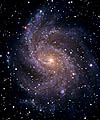
Description: NGC6946. NGC 6946 (Arp 29) is a face-on SAB(rs)cd galaxy
in the constellation Cygnus. This classification refers to the
presence of a small core with multiple well-defined arms (cd), with a
poorly-developed bar across the middle (AB) and
an inner confused ring (rs). Nearly twenty million light years from Earth,
it is over seventy thousand light years across.
Date: 1999.
Credit: Simon Driver (St. Andrews).
Technical information: Image taken using the Wide Field Camera on the
Isaac Newton Telescope on 12th June 1999.
Available formats: [ JPEG (510 K) | TIFF (1,275 K) | PDF (with text) ]


Description: NGC 253 Galaxy.
Credit: Peter Sorensen, Robert Greimel, Nik Szymanek.
Date: 3 November, 2000.
Technical information: Image taken using the Wide Field Camera on the
Isaac Newton Telescope. Shown here it's the whole mosaic of CCDs. In order
to get a true-colour impression, 3 images were obtained and combined using
filters Kitt Peak B, Harris V and Sloan-Gunn r'. Images were reduced using
the new ING pipeline reduction system'Gigawulf'.
Available formats: JPEG1 (318 K) | TIFF1 (5,381 K) | JPEG2 (86
K)
1 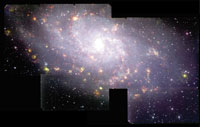 2
2 3
3
Description: M33 Galaxy. This
galaxy is one of the finest examples of a spiral galaxy in the sky and is
about one degree across. The galaxy is a member of the 30 or so galaxies of
the Local Group and is close enough - about 2.5 million light years - for us
to study the anatomy of a galaxy in great detail. Many individual bright
stars pepper the delicate spiral arms which are in turn sprinkled with pink
star-forming regions. Several of the clumps of bright stars and their
associated nebulae are bright enough to have been catalogued as separate
objects.
Date: Picture 1: 1999, Picture 2: 1999, Picture 3: 1992.
Credits: Image 1 is courtesy L. Magrini and M. Perinotto (University
of Florence), R. Corradi (ING), and A. Mampaso (IAC).
Image 2 is courtesy
Simon Tulloch (ING) and Nik Szymanek (SPA).
Image 3 is copyright Malin-IAC-RGO.
Technical information: Image 1 was obtained with the mosaic CCDs of
the Wide Field Camera at the INT. The image is a composition of frames taken
in three narrow bands: the green colour represents the galaxian emission in
[OIII] nebular line, red is the H-alpha hydrogen emission and blue is mainly
stellar light taken through a continuum filter centred at 555.0 nm
(Stromgren Y). In only one observing night, and with two positionings of the
telescope, it was possible to cover the whole galaxy which has a size of
approximately one degree in the sky. More information: Another View of M33 - ING Newsletter
article.
Image 2 is a CCD true-colour
composition achieved with the 2 detector WHT Prime Focus camera. Exposure
time was 10s.
Image 3 is a 3-colour photographic composition from the Isaac Newton
Telescope.
Available formats:
Image 1: DIN-A4: [ JPEG (54 K) | TIFF (1,089 K) | PDF (with text) ]. Large
format (480 mm wide): [ PDF (2,329) | TIFF (37,987 K) | PDF (poster with text)].
Image 2: [ JPEG (233 K) | TIFF (8,113 K) ]
1 2
2  3
3 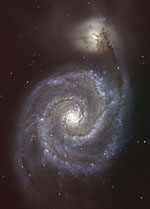 4
4 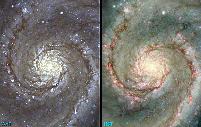
5 
M51 galaxy, known as The Whirlpool Galaxy, is a bright spiral galaxy
fairly close to us (7.5 Megaparsecs = 25 million light years). To the north of M51, at the bottom of the picture, is a companion
galaxy which is being disrupted by the gravitational tidal forces of the
main galaxy.
Date: Image 1: 1997. Images 2 and 3: June 2000. Image 4: April
2001. Image 5: July 2009.
Credit: Image 1: Peter Bunclark (IoA). Image 2: Javier
Méndez (ING) and
Simon Tulloch (ING). Image 3: Javier Méndez (ING) and Nik Szymanek
(SPA). Image 4: Javier Méndez, Nik Szymanek and HST Heritage Project. Image 5: Pablo Rodríguez-Gil, Chris Benn, Andrew Cardwell.
Technical information:
Image 1: Shown here is a true-colour picture using BVR imaging on the
INT wide field camera. This picture was generated from three two-minute
exposures. The field size of this single Loral CCD
image is 12.6 arcminutes.
Images 2 and 3: True-colour image of M51 using the prime
focus camera on the WHT. Filter B is blue, filter V is green and filter R is
red. Exposure time was 300s in each band.
Image 4: A comparison between the M51 image taken using the PFC on the WHT
and an image of the same object from Hubble Space Telescope Heritage
Project.
Image 5: ACAM first-light image of spiral galaxy Messier 51. This is a composite of images through several different filters, with red colour highlighting regions where new stars are forming.
The circular field of view is 8 arcmin across (about one quarter the angular diameter of the moon).
Available formats:
Image 1: JPEG (69 K).
Image 2: JPEG (149 K) | Compressed TIFF (6,892 K).
Image 3: JPEG (295 K) | TIFF (17,114
K) | PDF (with text) | PDF (poster with text).
Image 4: JPEG (118 K)
Image 5: JPEG

Description: The galaxy Dwingeloo 1. This is a barred spiral galaxy, probably one
of the largest and nearest galaxies, but undiscovered until 1994. This
is because it is hidden behind the disk of our own galaxy, the Milky Way
- as a result more than 99% of its light is absorbed by dust in our galaxy
before it reaches us. The galaxy was discovered using a combination of
radio observations and INT CCD imaging.
Date: 1994.
Credit: G. S. Hughes, & S. Maddox (RGO).
Technical information: Shown here is a true colour picture
using VRI CCD imaging on the INT.
Available formats: JPEG (58 K)
1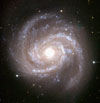 2
2 3
3
Description: M100 (NGC 4321). This is a barred galaxy in the Virgo
cluster. New infrared and optical
images taken with the WHT suggest that this "normal" spiral galaxy hides
a barlike structure in its heart.
Date: Image 2: 1995.
Credit: Image 1: J. E. Beckman, R. F. Peletier, J. H. Knapen, R. L. M.
Corradi, L. J. Gentet.
Image 2: ING Archive and Nik Szymanek.
Image 3: Johan Knapen and Nik Szymanek.
Technical information: Image 1: True colour image obtained using BVI CCD
imaging on the INT.
Image 2: Jacobus Kapteyn Telescope, Tek CCD, B, V and R filters.
Image 3: Jacobus Kapteyn Telescope. B, I, and H-alpha bands.
Available formats:
Image 1: JPEG (374 K) | TIFF (3,343 K)
Image 2: JPEG (126 K) | TIFF (11,625 K)
Image 3: JPEG (100 K) | TIFF (4387 K)
1 2
2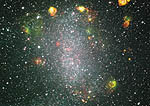
Title: NGC 6822 or Barnard's galaxy.
Description:
1: NGC 6822 is one of the nearest galaxies and is
thus a member of the Local Group. The galaxy seems to be without symmetry and is
classified as an irregular. At one end of a prominent bar a few clouds of
glowing gas can be seen; at the other, bright bluish stars are scattered out
into what appears to be the first signs of a straggling spiral arm.
The fact that this
galaxy is near enough for us to be able to resolve a large number of its
individual stars makes it possible to study the star formation history
based on colour-magnitude diagrams.
2: Three-colour image of NGC6822. In each image, green is the [OIII] emission, red the Hα one, while blue corresponds to the broad band Sloan-g images, mainly dominated by continuum stellar emission. In these images, planetary nebulae stand out as green or yellow dots.
Date:
1: 1996.
2: 2003
Credit:
1: Carme Gallart (IAC) and Antonio Aparicio (IAC).
2: Romano Corradi (ING), Laura Magrini (University of Firenze, Italy)
Technical information:
1: This image was obtained using CCD imaging on
the Isaac Newton Telescope. Exposure
times were 900s in I, 900s in R, 1000s in V and 1200s in B.
2: Image obtained using the Wide Field Camera on the Isaac Newton Telescope.
Available formats:
1: BMP (2,463 K). These are true-colour pictures of the region
in the centre of the galaxy (gifs): RVB
IRV IRB
IVB | PDF (with text).
2: JPG (245 K) | TIFF (27,498 K)
1 2
2 3
3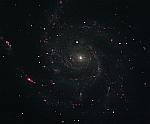 4
4
Description: M101 galaxy, the Pinwheel galaxy. M101 is one of the most prominent Grand Design spirals in
the sky. While quite symmetric visually, it is of
remarkable unsymmetry, its core being considerably displaced from the center
of the disk. Halton Arp has included
M101 as No. 26 in his Catalogue of Peculiar Galaxies as a "Spiral with One
Heavy Arm".
Date: Image 1: 1998. Image 2: 1998. Image 3: 2005. Image 4: 2009.
Credit: Image 1: Peter Bunclark (IoA). Image 2: Peter Bunclark (IoA)
and Nik Szymanek. Image 3: James Furness (ING). Image 4: R. Barrena and D. López (IAC).
Technical information:
Images 1 and 2: The picture was produced by composing three,
two-minute, exposures taken through R, V and B Harris photometric
filters, approximating the normal red, green and blue passbands. The area
shown is approximately 30x30 arc minutes, i.e. the full field of the Wide-Field Camera CCD mosaic at the prime-focus of the
Isaac Newton Telescope.
Image 3: The image was done with H-alpha, B, R, V filters. Exposure times 50 seconds in
each broad band, and around 4 minutes in H-alpha. H-alpha and R are given red, B blue and V green.
Image 4: Colour composite using filters Sloan g´, r´+H-alpha and i´.
Available formats:
Image 1: GIF (131 K)
Image 2: JPEG (177 K) | TIFF1 (6,395
K) | TIFF2 (18,485 K) | PDF (with text)
Image 3: JPEG (12.6M) | JPEG (85K)
Image 4: JPEG | TIFF | PDF (with text) | PDF (poster with text)

Title: IC 10.
Description: IC 10. Three-colour image of IC10. In each image, green is the [OIII] emission, red the H-alpha one, while blue corresponds to the broad band Sloan-g images, mainly dominated by continuum stellar emission. In this image, planetary nebulae stand out as green or yellow dots.
Date: 2003.
Credit: Romano Corradi (ING) and Laura Magrini (University of Firenze, Italy).
Technical information: Photographic 3-colour composition from the
Isaac Newton Telescope.
Available formats: JPG (175 K) | TIFF (15,124)
1 2
2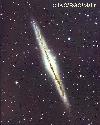
Title: NGC 891.
Description: NGC 891, an edge-on spiral galaxy. If we could view the
Milky Way from a distance of about 30 million light years it would look
something like NGC 891. But galaxies that look like this are quite rare
because the chance alignment of the thin disk of a spiral galaxy with our
line of sight is unusual. A few degrees either side of its orientation and
NGC 891 would be just another highly inclined spiral galaxy.
From this unusual vantage point we can see in NGC 891 the surprising
narrowness of the obscuring dust lane, a dark slightly irregular band across
the galaxy. We also see that it is yellowish, confirming that it is dust,
which absorbs blue light, as in the Milky Way. Also similar to the Milky Way
is the prominent central 'bulge' corresponding to the rich star clouds in
Sagittarius.
Credit:
Image 1: ING Archive and Nik Szymanek.
Image 2: Copyright Malin-IAC-RGO.
Date:
Image 1: 1995.
Image 2: 1992.
Technical information:
Image1:
Telescope: Jacobus Kapteyn Telescope.
Instrument: JAG CCD Camera.
Detector: Tek.
Filters and exposure times: Filters B, V and R.
Image 2: Photographic 3-colour composition from the
Isaac Newton Telescope.
Available formats:
Image 1: JPEG (77 K) | TIFF (12,089 K)
Image 2: PDF (with text)
1 2
2 3
3
Title: M95 Galaxy or NGC 3351.
Description: M95 was one of the galaxies in the key project of the
Hubble Space
Telescope for the determination of the Hubble constant: the HST was
employed to look for Cepheid variables and thereby determine this
galaxy's distance.
It is a barred spiral of type SBb, or SB(r)ab according to de Vaucouleurs'
classification, with nearly circular arms. Alan Sandage, in the Hubble Atlas of Galaxies, calls it a "typical ringed
galaxy".
Credit: Image 1: Nial Tanvir (IoA). Image 2: Johan Knapen (ING), Nik
Szymanek. Image 3: Johan Knapen and Nik Szymanek.
Date: Image 1: 1995. Image 2: 2000.
Technical information: Image 1: This picture was taken with the LDSS-2
instrument in imaging mode, on the WHT.Images taken in three filters (red,
green and blue) were combined to create this "true colour" picture.
Image 3: Jacobus Kapteyn Telescope. B, I, and H-alpha bands.
Available formats:
Image 1: GIF (115 K).
Image 2: JPEG (155 K) | TIFF (16,118
K) | PDF (with text) .
Image 3: JPEG (87 K) | TIFF (8886 K)

Title: M 96 Galaxy.
Description: M 96 or NGC 3368 Galaxy. M96 is the brightest member of the Leo I
group of galaxies, which is therefore also called the M96 group.
Its distance was determined to be about 41 million light years (after
corrections for the distance scale which are implied by the
results of ESA's Hipparcos satellite) by Nial R. Tanvir with the Hubble
Space Telescope by observing Cepheid variables.
Interpolated with the HST result of 35.5 million light years for its
neighbor M95, a value of 38 million light years can be adopted for the
group.
Date: 1995.
Credit: Nial Tanvir (IoA).
Tecnical information: True-colour CCD image obtained with the Isaac
Newton Telescope.
Available formats: JPEG (537 K)

Title: NGC 1300 Galaxy.
Description: NGC 1300 is a classic barred spiral
galaxy. It is 17 Mpc away and relatively face-on, with an inclination of
about 35
degrees. Because of it's size and inclination it is well-suited for a number
of studies.
Date: 1996.
Credit: J. A. López Aguerri, M. Prieto, C.
Muñoz-Tuñón, and A. M. Varela (IAC).
Technical description: True-colour CCD images from B, V and I imaging
on the Isaac Newton Telescope.
Available formats: GIF (243 K)

Title: NGC 3184 Galaxy.
Description: At a distance of 40 million light years away, NGC 3184 must be the showcase of its neighborhood. This galaxy has striking blue spiral arms with many pink star forming regions.
Date:
Credit: Johan Knapen and Nik Szymanek.
Tecnical information: Jacobus Kapteyn Telescope. B, I and H-alpha bands.
Available formats: JPEG (141 K) | TIFF (10,107 K)

Title: NGC 488 Galaxy.
Description: At an estimated distance of 90 million light years away NGC 488 is an intriguing galaxy despite its distance from us. This galaxy displays subtle and tightly wound blue spiral arms with a yellowish core. Astronomers that have recently observed this galaxy note that the stars in the disk are orbiting the galaxy at a break-neck speed of 360km/s. If this number seems large to you- bear in mind you are orbiting the center of the Milky Way at 220 km/s. By studying the velocity distribution of stars in a galaxy like this astronmers attempt to answer fundamental questions concerning the structure of spiral galaxies. For example, observations of this galaxy confirm that it is the process of star formation (molecular clouds) and not the kinematic motions of stars that determine the spiral appearence of spiral galaxies.
Date:
Credit: Johan Knapen and Nik Szymanek.
Tecnical information: Jacobus Kapteyn Telescope. B, I and H-alpha bands.
Available formats: JPEG (110 K) | TIFF (8629 K)

Title: NGC 1169 Galaxy.
Description:
Date:
Credit: Johan Knapen and Nik Szymanek.
Tecnical information: Jacobus Kapteyn Telescope. B, I and H-alpha bands.
Available formats: JPEG (102 K) | TIFF (11,463 K)

Title: NGC 3486 Galaxy.
Description:
Date:
Credit: Johan Knapen and Nik Szymanek.
Tecnical information: Jacobus Kapteyn Telescope. B, I and H-alpha bands.
Available formats: JPEG (140 K) | TIFF (6185 K)

Title: M 99 or NGC 4254 Galaxy.
Description: M99, although situated in constellation Coma Berenices, is one of the bright spiral members of the Virgo Cluster of galaxies. It is of type Sc, rotates clockwise (unlike the nearby spiral M100), and is unusually asymmetric, the nucleus shifted to the upper end of our picture. It is moving through the Virgo Cluster with a high proper (or peculiar) velocity of at least about 1200 km/sec, by chance in a direction pointing away from us.
Date:
Credit: Johan Knapen and Nik Szymanek.
Tecnical information: Jacobus Kapteyn Telescope. B, I and H-alpha bands.
Available formats: JPEG (85 K) | TIFF (19,348 K)

Title: NGC 4725 Galaxy.
Description:
Date:
Credit: Johan Knapen and Nik Szymanek.
Tecnical information: Jacobus Kapteyn Telescope. B-band.
Available formats: JPEG (102 K) | TIFF (944 K)

Title: M58 or NGC 4579 Galaxy.
Description: M58 is one of the four barred spiral galaxies in Messier's catalog (the others are M91, M95, and M109), although it is sometimes classified as intermediate between normal and barred spirals. It is one of the brightest galaxies in the Virgo cluster.
Date:
Credit: Johan Knapen and Nik Szymanek.
Tecnical information: Jacobus Kapteyn Telescope. B, I and H-alpha bands.
Available formats: JPEG (227 K) | TIFF (22,650 K)
1:  2:
2:  3:
3: 
4: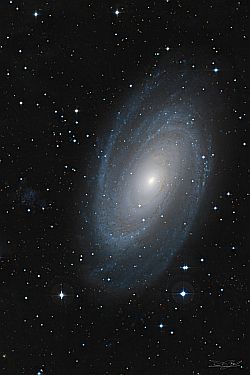
Title: M81 Galaxy.
Description: This ground-based image shows the spiral galaxy Messier 81 in its entirety. The image is a
combination of exposures from the Isaac Newton Telescope on La Palma (courtesy of Jonathan Irwin) and
Digitized Sky Survey 2 images.
Date: 1: 2003. 2: 2013. 3: 2015. 4: 2019.
Credit: 1: ESA/INT/DSS2. 2: Teo Mocnik (ING) and Kamil Hornoch. 3: Iñaki Ordóñez (ING) and Kamil Hornock (Ondrejov). 4: Abel de Burgos Sierra (ING).
Tecnical information:
1: Isaac Newton Telescope's Wide Field Camera and 2 images from DSS2.
2: Observed with INT-WFC on 14th Oct 2013. Filters: H-alpha 4x400s (red), Sloan r 3x120s (green and blue).
Software: Theli - image reduction of the mosaic; IRAF - image reduction of the single CCD image; FITSLiberator – intensity stretching; MATLAB – RGB composition, filtering and minor corrections
3: FoV (CCD4) is ~10 x 30 arc min. Filters and channels: R: H-alfa; G: r; B: B. Images exposure time: H 4x180, r 4x180, B 4x60. Orientation is N up E left.
4: The Bode Galaxy.
Available formats:
1: JPEG (442 K) | TIFF (11,422 K) | PDF (with text)
2: JPEG | TIFF |
JPEG mosaic | TIFF mosaic
3: JPEG
4: The Bode Galaxy.

Title: M83 Galaxy.
Description:
Date: 17 February 2004.
Credit: Chris Benn (ING), Nik Szymanek (University of Hertfordshire).
Tecnical information: PFC on William Herschel Telescope, CCD#1.
Available formats: JPEG (589 K) | TIFF (4246 K) | PDF (with text)
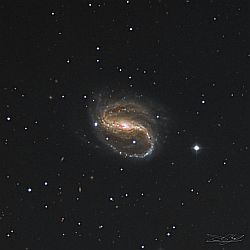
Title: NGC7479 Galaxy.
Description: NGC7479
Date: 2019.
Credit: INT suppport astronomers.
Tecnical information: WFC on INT.
Available formats: PNG.

 2
2
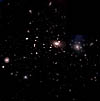
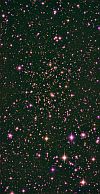













































 2
2


























